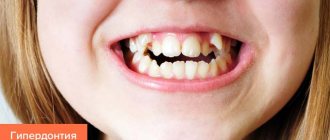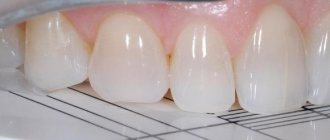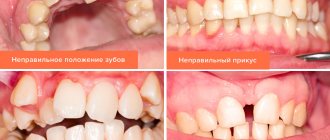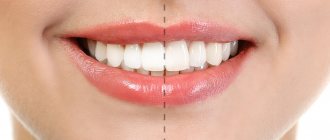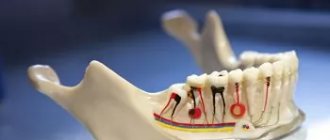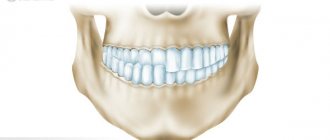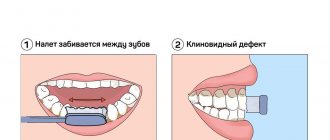The first reaction of parents who notice that their child is growing a second row of teeth is natural fear. In dentistry, it is generally accepted that there are two causes of pathology:
- abnormal growth of molars;
- polyodontia or supernumerary teeth.
Normally, permanent teeth replace baby teeth only after the latter fall out. The germ of the molar tooth stretches upward, thereby contributing to the destruction of the roots. With some features of jaw development, this does not happen, which is why the second row appears.
Reasons for the growth of the second dentition in a child
Double or “shark” teeth in children appear when the baby tooth and the rudiment of the molar are located at different points in the oral cavity. When a new set erupts, the baby tooth remains in place. A tooth grows above a tooth, which not only does not look aesthetically pleasing, but also interferes with the development of the rest of the row.
The most common reason why teeth do not change is improper breathing. A lot depends on how a child breathes. Breathing disorders lead to problems with bite, deterioration of posture and changes in facial shape.
A child’s jaw develops correctly only when he breathes correctly through his nose. The tongue in this position presses on the palate from the inside. A natural semicircular shape of the jaw is formed, in which there is enough space for all the molars. This is why it is so important to teach your child to breathe through his nose to prevent the growth of the second row of teeth.
Useful tips
Before removing an incorrectly positioned wisdom tooth, we offer a number of tips that will help you prepare and go through the operation more comfortably:
- Try to make an appointment for tooth extraction in the morning. During the night, the hormone cortisol accumulates in the body, which helps to survive stressful situations. In addition, one should take into account the fact that the inevitable bleeding from the wound at the site of the former tooth will stop by the evening, and the person will be able to sleep peacefully.
- Eat well before surgery. As a result, saliva will be released in smaller volumes, and then you will need to leave your jaws alone and not eat for some time.
- If possible, immediately use a cold object and periodically apply it to your cheek on the way home to prevent swelling from forming. A pack of dry ice from a motorist's first aid kit will do.
- At home, rinse your mouth with clean water or medications recommended by your doctor.
- Take medications in the correct dosage, do not get carried away with self-medication and self-prescription of drugs.
Recommendations for a better rehabilitation period after removal of an impacted wisdom tooth:
- You will need to allow a blood clot to form at the site of the extracted tooth. His presence is mandatory. The clot protects the socket from the penetration of bacteria and prevents complete deformation of the gums. Dry socket is dangerous and provokes inflammation.
- Do not touch the blood clot with your tongue, toothbrush bristles, or cutlery. It is not even recommended to use mouth rinse for 2-3 days after surgery. It is better to take the medicine into your mouth, hold it for a while and spit, avoiding the chance of dislodging the clot.
- To stop bleeding, it is permissible to use sterile cotton wool or gauze swabs. It is allowed to moisten with Chlorhexidine, Miramistin. It is prohibited to use hydrogen peroxide!
- For several days you will have to eat soft food and maintain an acceptable temperature of food and drinks.
- You are supposed to temporarily give up physical activity and training. Baths and saunas, swimming pools, solariums are prohibited.
- You cannot heat the surgical area, as this will cause a dangerous inflammatory process. You can apply ice, but under no circumstances keep it on your cheek all the time. Optimal rhythm: 5 minutes cooling, 5 minutes break. If you don’t have ice at home, bags of frozen vegetables and meat from the freezer will do.
- Maintaining oral hygiene is not prohibited. The main thing is to leave the operated area alone in the first days and not try to thoroughly clean the teeth located near the wound. Disinfection can be carried out with solutions of Chlorhexidine, Furacilin, holding it in the mouth and spitting it out, without rinsing.
Medicine knows of cases when wisdom teeth are prescribed to be preserved. But if it grows, pushing neighbors, lies horizontally or rests on the roots of nearby teeth, there is no need to think twice. Such an eight is considered problematic and is deleted without regret.
Removal of wisdom teeth using ultrasound in Moscow without pain and complications
If a wisdom tooth grows horizontally and puts pressure on the adjacent tooth
Supernumerary teeth in children
The appearance of additional tooth buds is rare, occurring in only 2% of cases. The anomaly is associated with a disorder of embryonic development. A tooth that appears above a child's tooth is usually removed. But this does not always happen: if the tooth does not disturb the shape and aesthetics of the dentition, the dentist can leave it.
Sometimes supernumerary teeth are located outside the dental arch. The appearance of a tooth on the palate of a child is rare, however, this is no exception. There is no need to be afraid of this: it does not affect your health in any way. The Natadent clinic has a pediatric orthodontist who will help solve this problem quickly and painlessly.
Reasons for appearance
Medicine does not give an exact answer why the program fails in the human body and supernumerary teeth appear.
Hypotheses explaining the etiology of the phenomenon:
- Atavism hypothesis . Supernumerary teeth are a return to the original number of dental elements, which was normal for human ancestors (it is believed that they had 6 incisors on the upper and lower jaws).
- Theory of splitting of the tooth germ . Hyperdontia is a consequence of impaired activity of the dental plate during embryonic development, as a result of which a significantly larger number of dental buds are formed from it. The hypothesis is supported by the increase in recent decades in the number of cases of the appearance of extra teeth as a result of the influence of unfavorable environmental conditions, thyroid diseases and other negative factors.
What to do if the child’s teeth grow in the second row?
When a doctor sees a tooth above a patient’s tooth, he immediately understands what’s wrong. First, the orthodontist removes the baby tooth. After this, the permanent tooth will move into place on its own under the action of the tongue muscle, if there is enough space. But what to do if a child has a lack of space for molars?
The primary task of the dentist and parents will be to restore normal breathing. At this stage, it is necessary to “retrain” the muscles of the mouth to work differently. This is where trainers or mouthguards come to the aid of specialists.
Orthodontic appliances solve several important problems:
- train the muscles of the oral cavity, stimulating their natural development;
- correct the direction of development of the child’s jaws;
- correct the position of the tongue in the oral cavity;
- teach the child to breathe through the nose;
- get rid of bad habits.
Wearing trainers is most often considered as a preparatory stage. After this, more serious orthodontic treatment begins with the use of braces. However, here the first step is the most important, since the effectiveness of further work depends on it.
Let's consider a clinical example of transposition correction using orthodontics
Patient N., 14 years old, came with her mother to the dental clinic. Complaints were made about the incorrect location of the canine on the upper jaw on the right. We already had a panoramic radiograph in hand, which complemented the analysis of the clinical situation in the oral cavity. To clarify the diagnosis and determine the optimal treatment plan, the patient was referred for a computed tomography scan of the jaws
After analyzing the diagnostic data, it was found that the root of the first premolar 1.4 is inclined towards the persistent primary canine 5.3, and the root of the permanent canine 1.3 is projected into the area between the roots of the premolars. Consequently, the situation was complicated by the fact that it was necessary not only to move the crowns, but also to “separate” the roots of the canine and premolar in their places.
When discussing the treatment plan with the patient and parents, a clear decision was made: to put the teeth in their places, despite the duration and complexity of the correction. The treatment method involved fixing a metal brace system initially only on the upper jaw, and after moving the crowns and roots, installing a brace system on the lower jaw for final correction and detailing the position of the teeth.
How to understand that a child is at risk of growing teeth in two rows?
Attentive parents should monitor the process of teeth growth and loss. The change of dentition begins at 6-8 years: the first to fall out are the central and lateral incisors. At 9-11 years old, the lower canines change. By the age of 10-12, the upper canines and small molars grow. The formation of the bite ends at the age of 13-14 years.
A child’s tooth grows above the tooth when the baby tooth does not leave its place in due time. In this case, parents should definitely consult a doctor. The earlier the pathology is detected, the easier it is to correct the child’s second dentition.
You don’t have to wait for your baby teeth to suddenly fall out on their own! If you notice that your child’s molars are cutting in, but his baby teeth aren’t even loose yet, take him to the dentist. With “shark” teeth, not only the appearance, but also the shape of the jaw is disrupted.
After removal of a recumbent wisdom tooth
While the anesthesia is in effect, the patient does not feel pain. But when the effect of the drug wears off, sensitivity gradually returns, and the person begins to feel pain. This pain is physiological, because the doctor cut the tissue, touched the bone, and the nerve endings were damaged. After a few days, the sensations finally subside. The following symptoms are possible:
- Mild hyperthermia;
- General malaise, weakness;
- Development of edema;
- Bleeding in the socket area.
Sometimes bleeding from the site of tooth extraction frightens a person; this is a natural reaction. The patient always thinks that he has lost more blood than actually happened. Sometimes the phenomenon continues for hours and usually stops completely by the evening. But if the nature of the bleeding remains unchanged throughout the day, the pain increases, and purulent spots appear in the socket, then the discomfort cannot be tolerated. This requires quick response measures to stop the developed inflammatory process.
Mouthguard as a preventive measure for the second dentition
In dental practice, mouth guards are worn by children over four years of age. At this age, the child is already consciously approaching wearing a trainer and can wear it for a long time. The device is made according to individual casts, taking into account the characteristics of jaw development. The material from which the mouthguard is made is soft and does not injure the mucous membrane.
From the age of two, children can wear removable plates to correct bad habits. If a child often sucks a pacifier or fingers, his bite does not develop properly. These children are more likely to have teeth growing in two rows. A soft plate will help avoid this.
In our clinic, parents trust doctors with their most valuable asset – their children. You can rely on our specialists in any situation. To confirm these words, we publish reviews from our grateful clients.
Natadent specialists know how to win over the youngest patients. Most guys leave the dentist's office without the same fears. True professionals in their field not only master their tools flawlessly, but also make every trip to them as comfortable as possible.
The first stage of treatment for tooth transposition
The first step was to move the crown of permanent canine 1.3 into place. Naturally, primary canine 5.3 was removed before installing braces at the stage of sanitation of the oral cavity. For this, a NiTi spring was used to open from the bracket on the second premolar to the canine crown on one side, and light traction with an elastic chain on the other.
The final stage of transposition treatment - making teeth beautiful
This was followed by the long-awaited getting rid of the braces system, cleaning and polishing of the teeth and the manufacture of fastening devices - retainers. A removable transparent night guard (aligner) was made for the upper jaw, and a non-removable wire retainer from canine to canine was made for the teeth of the lower jaw. Control examinations are recommended every six months for several years.
Conclusions of orthodontist Alexey Trezubov:
- Orthodontic treatment of tooth transposition should be considered as the preferred method of treatment.
- When planning treatment, it is important to take into account the patient’s age, degree of transposition, location of the roots, thickness of the bone tissue in the area of displacement and gum biotype.
- If the orthodontic method of correction is considered inappropriate, then other methods of correction are used.
- During such a rather complex movement of teeth, the orthodontist must be very careful and attentive, monitor the situation at each visit and make the necessary changes.
- The prognosis for treatment of such patients is in most cases favorable, but do not forget about the retention period.
Why didn't my baby tooth fall out?
The structure of temporary and permanent teeth has certain differences. Dairy teeth have the same shape as molars, but they are smaller in size, their roots are much shorter, and they grow in the amount of only 20 pieces versus 32 permanent ones, including wisdom teeth. The service life of “children’s” teeth is also short: their roots begin to dissolve (dentists say “resorb”) approximately 2 to 3 years after they are fully formed. The process begins from the area where the crowns of the permanent teeth growing underneath touch them.
However, it happens that the rudiments of molars do not form for some reason. In this case, the roots of the milk teeth most often dissolve under the influence of the rudiments of adjacent permanent teeth. But sometimes this does not happen, and then “children’s” teeth are preserved in adults - doctors call them persistent, from the Latin persistere - to remain, to remain.
The reasons for the absence of permanent tooth buds can be different. Sometimes these are hereditary characteristics, metabolic disorders or disorders of the endocrine glands, trauma and osteomyelitis of the jaws. Chronic and acute inflammatory processes in baby teeth, in particular, periodontitis that is not cured in a timely manner, can also lead to damage and death of the rudiments of permanent teeth.
It also happens that the rudiments of permanent teeth, although they are formed, lie very deep, without touching the roots of milk teeth. This may be caused by insufficient space or misalignment of the permanent tooth. In these cases, milk teeth can remain in an adult.
